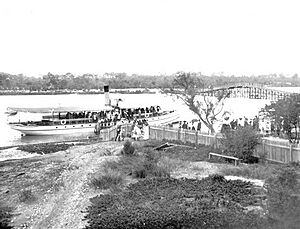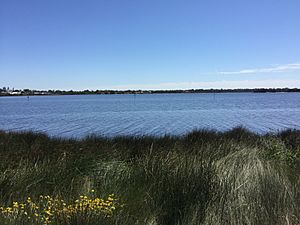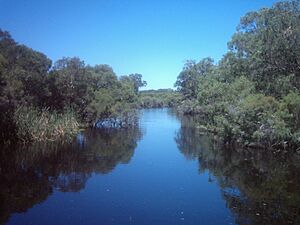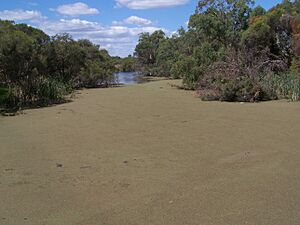Canning River facts for kids
Quick facts for kids Canning River |
|
|---|---|

Canning River from southern shore looking north towards Mount Henry overlooking Aquinas Bay.
|
|
| Native name | Nyungar: Djarlgarra |
| Country | Australia |
| State | Western Australia |
| City | Perth |
| Physical characteristics | |
| Main source | Wandering |
| River mouth | Swan River Melville Water 32°00′11″S 115°51′02″E / 32.0031568°S 115.8506084°E |
| Length | 110 km (68 mi) |
| Basin features | |
| Tributaries |
|
The Canning River, known as Djarlgarra in the local Nyungar language, is a really important river in Western Australia. It's like a big helper river, or "tributary," that flows into the famous Swan River. The river is about 110 kilometers (68 miles) long and winds its way through many suburbs of Perth.
Contents
River's Journey
The Canning River starts high up in the Darling Scarp hills. From there, it gently flows through many suburbs of Perth, the capital city of Western Australia. You can see it in places like Cannington, Thornlie, and Riverton. Finally, it joins the Swan River at a wide part called Melville Water, just after the Canning Bridge.
Bridges Over the River
Many bridges cross the Canning River, helping people travel around Perth. Some of the well-known bridges include:
- Canning Bridge
- Mount Henry Bridge
- Shelley Bridge
- Riverton Bridge
- Kent Street Weir Bridge
- Djarlgarra Bridge
Special Spots Along the River
The Canning River has several interesting spots along its banks. These places often have unique names and features:
- Coffee Point: This spot is east of Point Heathcote on the Swan River.
- Deepwater Point: You can find this on the western side in the Mount Pleasant area.
- Salter Point: This is a very narrow part of the river, with the Salter Point suburb on one side.
- Prisoner Point: Located on the south shore in the Shelley suburb.
- Wadjup Point: Found to the northwest of the Shelley Bridge.
River's History
The first time Europeans saw the mouth of this river was in 1801. A French exploring group named it Entrée Moreau.
The river got its current name, Canning River, in 1827. Captain James Stirling explored the area and named it after George Canning. He was a very important British politician and the Prime Minister at that time. His government helped fund Stirling's trip.
In November 1829, just five months after the Swan River Colony was started, Governor James Stirling picked a spot for a new town. This town, called Kelmscott, was built right on the banks of the Canning River.
Convict Fence
A special structure called the Canning River Convict Fence was partly built and kept up by convicts. This fence is still a famous landmark today. It was mainly used to help barges carry timber from Mason's Timber Mill in the Darling Ranges.
The river is home to lots of amazing wildlife. You might see dolphins swimming, pelicans gliding, and swans gracefully floating. Many other types of birds also live along the river.
Algae Blooms
Sometimes, the Canning River experiences something called an algae bloom. This happens naturally when there are too many nutrients in the water. Human activities, like farming and using fertilizers in gardens, can cause these nutrient levels to rise.
These blooms can be harmful to both animals and people. The Swan River Trust keeps a close eye on the river's nutrient levels and algae growth. They issue warnings and sometimes close parts of the river to keep everyone safe. The Trust also works to clean up the river and reduce the amount of nutrients flowing into it.
One interesting plant that helps is called Azolla. When carpets of Azolla grow on the river, they can block sunlight from reaching the algae. They also soak up a lot of the extra nutrients. However, too much Azolla can sometimes cause problems like less oxygen in the water and a strong smell.
See also
 In Spanish: Río Canning para niños
In Spanish: Río Canning para niños






